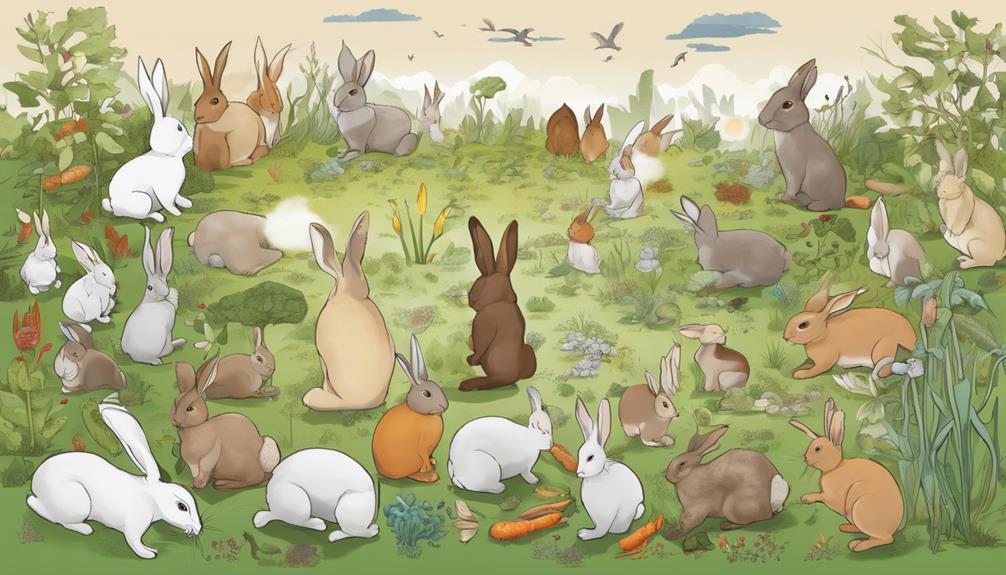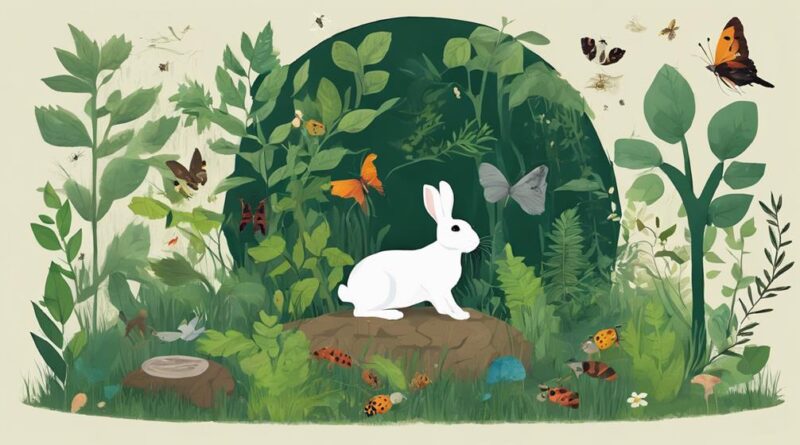7 Key Tips: Rabbits' Impact on the Food Chain
When it comes to rabbits and the food chain, remember their vital role as primary consumers shaping the ecosystem. Their population can be influenced by factors like food availability and predation. Understanding their behavior is crucial for managing ecosystems. Overpopulation might lead to imbalances and habitat destruction. Rabbits help regulate plant populations by grazing and are prey for various predators. Their grazing impacts plant diversity and ecosystem health. Monitoring rabbit populations is key for effective management. Consider the interconnectedness between rabbits, predators, and ecosystem balance. By managing rabbit populations sustainably, you ensure harmony within the food chain.
Rabbits as Primary Consumers
Rabbits actively contribute to the food chain as primary consumers, playing a crucial role in ecosystem dynamics by consuming plant material and passing energy along to higher trophic levels. Their foraging behavior is a key aspect of their role in the ecosystem. Rabbits are herbivores, primarily feeding on grasses, clover, and other vegetation. Their feeding habits impact the plant populations in their habitat, shaping the plant community structure through selective grazing.
Population dynamics are intricately linked to rabbits' role as primary consumers. Their population size is influenced by factors such as food availability, predation, and environmental conditions. When resources are abundant, rabbit populations can increase rapidly. Conversely, during times of scarcity or when predation pressure is high, rabbit numbers may decline. These fluctuations in rabbit populations have ripple effects throughout the ecosystem, affecting the abundance of their food sources and the animals that prey on them.
Understanding the foraging behavior and population dynamics of rabbits is essential for managing ecosystems effectively. By monitoring rabbit populations and their interactions with plants and other animals, conservationists and ecologists can make informed decisions to maintain biodiversity and ecosystem balance. Overall, rabbits play a fundamental role as primary consumers in the food chain, shaping the dynamics of their habitats through their feeding habits and population fluctuations.
Impact of Rabbit Overpopulation
An overpopulation of rabbits can have significant ecological ramifications, impacting various aspects of the ecosystem's dynamics and biodiversity. When rabbits multiply beyond the environment's carrying capacity, they can lead to an ecological imbalance by exerting immense pressure on the available resources. This overgrazing behavior can result in habitat destruction, where vegetation is stripped off at a rate faster than it can regenerate, affecting not only plants but also other species dependent on those plants for food and shelter.
Furthermore, the agricultural damage caused by an excessive rabbit population can be considerable. Rabbits are known to feed on crops, causing economic losses for farmers and disrupting food production systems. This agricultural damage can have far-reaching implications on food security and the economy, especially in regions where agriculture plays a significant role. In such situations, effective pest control measures become crucial to mitigate the impact of rabbit overpopulation.
Rabbits' Role in Ecosystem Balance
Occasionally, the presence of rabbits within an ecosystem plays a crucial role in maintaining a delicate balance among various species. Rabbits, as herbivores, have a significant impact on ecosystem dynamics through their interactions with plants and other herbivores. By consuming vegetation, rabbits help regulate plant populations, preventing overgrowth in certain areas. This grazing behavior can also create open spaces for new plant growth and promote biodiversity within the ecosystem.
In terms of herbivore interactions, rabbits compete with other herbivores for resources such as food and shelter. This competition can influence the distribution and abundance of different species within the ecosystem. Additionally, rabbits serve as prey for various predators, contributing to the intricate web of interactions that shape the ecosystem.
Wildlife management often involves strategies for controlling rabbit populations. Due to their high reproductive rates, rabbits can quickly reach levels that exceed the carrying capacity of their habitat. In such cases, population control measures may be necessary to prevent habitat degradation and maintain a healthy ecosystem balance.
Understanding the role of rabbits in ecosystem balance is essential for effective conservation and management practices. By considering the impacts of rabbits on vegetation, herbivore interactions, and population dynamics, wildlife managers can implement strategies that promote biodiversity and sustainability within ecosystems.
Predators' Dependence on Rabbit Population
Predators in an ecosystem often rely on the population dynamics of rabbits to sustain their own numbers and ensure ecological balance. The relationship between predators and rabbits is crucial for maintaining the health and stability of the ecosystem. Predators such as foxes, hawks, and snakes depend on rabbits as a food source. When the rabbit population is abundant, predators have enough prey to feed on, which helps in regulating the predator population. This, in turn, prevents any one species from dominating the ecosystem and promotes biodiversity.
The dependence of predators on rabbit populations creates a delicate balance within the ecosystem. If the rabbit population were to decline significantly due to various factors like disease or habitat loss, predators would face food scarcity. This scarcity could lead to a decline in predator numbers, disrupting the natural order of the ecosystem. On the other hand, if the rabbit population were to increase uncontrollably, they could overgraze vegetation, leading to habitat degradation and impacting other species within the ecosystem.
Therefore, the population dynamics of rabbits play a crucial role in maintaining the equilibrium of the ecosystem. By understanding the interconnectedness between predators and rabbits, we can appreciate the intricate web of relationships that sustains life in the natural world.
Rabbit Grazing and Plant Communities
The impact of rabbit grazing on plant communities within an ecosystem is a pivotal aspect of understanding the intricate dynamics of species interactions and ecological balance. Grazing behavior is a fundamental aspect of rabbit foraging that can significantly influence plant diversity and ecosystem health.
Rabbits are known for their selective feeding habits, preferring certain plant species over others. This selective grazing can lead to shifts in plant community composition, favoring some species while inhibiting the growth of others. Such alterations in plant diversity can have cascading effects on the entire ecosystem, affecting nutrient cycling, soil structure, and the availability of food and shelter for other organisms.
The intensity of rabbit grazing can also impact the regeneration of plant populations. Overgrazing by rabbits can hinder the ability of plants to reproduce and replenish their populations, leading to declines in plant abundance and diversity over time. This can disrupt the delicate balance within plant communities and ultimately affect the stability and resilience of the ecosystem as a whole.
Understanding the intricate relationship between rabbit grazing and plant communities is crucial for effective ecosystem management and conservation efforts. By monitoring rabbit populations and their grazing patterns, conservationists and land managers can implement strategies to maintain plant diversity, enhance ecosystem health, and preserve the overall balance of the food chain.
Rabbits and Biodiversity Conservation
In considering biodiversity conservation efforts, the role of rabbits in ecosystem dynamics and species interactions warrants close examination. Rabbits play a significant part in influencing habitat structure and plant diversity through their foraging habits. By consuming various plant species, rabbits can impact the composition and distribution of vegetation within an ecosystem. This selective grazing behavior can lead to changes in plant community structure, potentially favoring certain plant species over others.
Rabbits also contribute to biodiversity benefits by creating microhabitats through their burrowing activities. Their burrows provide shelter for a variety of small mammals, reptiles, and invertebrates. These microhabitats can enhance overall species richness and diversity within an ecosystem by offering refuge and nesting sites for different organisms.
Furthermore, rabbits serve as prey for numerous predators, thus forming an integral part of the food web. Their presence helps support populations of predators such as foxes, hawks, and snakes. This predator-prey relationship is essential for maintaining the balance of species within an ecosystem.
Managing Rabbit Population for Sustainability

Rabbits' population management is crucial for maintaining ecosystem balance and sustainability. Effective population control measures are essential to prevent overgrazing and habitat destruction, which can have cascading effects on other species and disrupt the delicate balance of the food chain. Sustainable management practices aim to strike a balance where rabbit populations are kept in check to minimize their impact on vegetation and other wildlife while ensuring their presence contributes positively to the ecosystem.
One approach to managing rabbit populations is through the implementation of targeted culling programs. By selectively reducing rabbit numbers in specific areas where their impact is most significant, such as conservation sites or agricultural lands, it's possible to mitigate their detrimental effects on biodiversity. These programs need to be carefully planned and monitored to avoid unintended consequences and ensure the long-term effectiveness of population control efforts.
In addition to culling, habitat modification can also play a role in managing rabbit populations sustainably. By altering landscapes to make them less favorable to rabbits, such as by introducing natural predators or implementing fencing strategies, it's possible to create environments where rabbit numbers are naturally regulated without the need for extensive human intervention. Finding the right combination of population control methods tailored to specific habitats and ecosystems is key to ensuring that rabbit populations coexist harmoniously within the food chain while supporting overall ecological sustainability.
Frequently Asked Questions
Do Rabbits Have Any Unique Social Behaviors Within Their Communities?
Rabbits exhibit various unique social behaviors within their communities. They engage in complex social interactions, such as grooming each other to strengthen bonds and establish hierarchy.
Communication patterns among rabbits involve a mix of vocalizations, body language, and scent marking to convey messages about territory, mating, and danger.
These social behaviors play a crucial role in maintaining group cohesion and ensuring the survival of the community.
How Do Weather Patterns Affect Rabbit Populations in Different Regions?
Weather patterns play a crucial role in shaping rabbit populations in various regions. Factors like temperature, precipitation, and seasonal changes impact the availability of food and shelter, directly influencing population dynamics.
For instance, extreme weather events such as droughts or heavy rainfall can lead to fluctuations in rabbit numbers. Understanding how weather patterns affect rabbits is essential for predicting population trends and implementing effective conservation strategies.
Are There Any Diseases That Specifically Target Rabbit Populations?
When it comes to disease outbreaks in rabbit populations, various illnesses can significantly impact their numbers. Parasites are a common culprit that can weaken the rabbits' immunity defenses, making them vulnerable to infections.
These diseases often play a vital role in population control within rabbit communities. Understanding the dynamics of these outbreaks and how they affect rabbit populations is crucial for wildlife management and conservation efforts.
Can Rabbits Adapt to Urban Environments and Thrive?
Rabbits can adapt to urban environments and thrive due to their remarkable population dynamics. These creatures have shown a high level of flexibility in adjusting to human-altered landscapes.
Their ability to reproduce quickly and find suitable habitats within cities allows them to establish stable populations. This urban adaptation can lead to both challenges and benefits, impacting local ecosystems and human activities.
How Do Rabbits Contribute to Soil Health in Their Habitats?
Rabbits naturally contribute to soil health in their habitats by enhancing soil enrichment through their grazing habits. They feed on grasses and plants, which helps to maintain vegetation at an optimal level, preventing overgrowth that could hinder soil quality.
Conclusion
In conclusion, rabbits play a crucial role in the food chain as primary consumers, but their overpopulation can have negative impacts on ecosystems. Predators depend on rabbits for food, and their grazing habits can affect plant communities.
It's important to manage rabbit populations effectively to maintain ecosystem balance and biodiversity conservation. By understanding the impact of rabbits on the food chain, we can work towards sustainability and the health of our natural environments.
